Planning for Railway Station Network Sustainability Based on Node–Place Analysis of Local Stations
Abstract
1. Introduction
2. Research Background
3. Methodology
- Frequency of train services (N1): The official Korail site provides a timetable for KTX and other train services. Based on the Gyeongbu line timetable, we extracted the average number of train arrivals and departures at each station per day.
- Number of connections served (N2): Similarly, the average number of train connections provided by each train station per day was measured using the Gyeongbu line timetable data from the official Korail site.
- Number of nearby subway stations (N3): Subway stations provide timely transportation services that conveniently complement the train station usage experience. While some train stations benefit from the closeness of one or even three linked subway stations using the same metro card (mostly divided by a single gate), some stations are unfortunately faced with limited accessibility because of the unavailability of subway services.
- Number of available bus stations within 300 m (N4): The bus also plays a significant role in providing accessibility to railway services. The bus stations within approximately 300 m were measured and counted.
- Number of buses (N5): Frequent bus services near train stations are often highly valued, as they are key to easy transferability.
- Number of parking spaces (N6): The number of parking spaces was collected from the official Korail site. Parking spaces represent readiness to assist service users, who are interested in half-day or even longer travel, in using train stations. The availability and reliability of parking spaces are vital for enhancing the overall quality of train stations.
- Number of residents in the area (P1): The number of residents within the city where train stations are located was measured based on Korean Statistical Information Service data. With the exception of Station 4 (Gwangmyeong), Station 5 (CheonanAsan), Station 8 (Gimcheon), Station 10 (Singyeongju), and Station 12 (Miryang), residents in the cities where train stations are located were measured. For others, due to limited data availability, the number of residents in the provinces is used instead.
- Number of employees in the corresponding province (P2): Bertolini [24] analyzed four economic clusters: (i) retail, hotel, and catering; (ii) education, health, and culture; (iii) administration and services; and (iv) industry and distribution. In this study, we utilized eight economic clusters: (1) agricultural forestry and fisheries; (2) mining and manufacturing; (3) manufacturing; (4) social overhead capital and other services; (5) construction; (6) wholesale, retail, and accommodation; and (8) electricity, transportation, telecommunication, and finance. The data were obtained from the Korean Statistical Information Service. Our datasets represent provinces or cities, depending on the availability of the data.
- Degree of multifunctionality (P3): While most stations in Korea primarily serve the purpose of providing train access to consumers, some of the stations also provide impeccable convenience for both consumers and retail stores. For example, Station 2 (Yeongdeungpo) is connected to a large department store and its underground shopping mall. Not only do train stations enhance functional quality from the transportation perspective, but they also demonstrate significant contributions to happiness through their facilitation of other social activities that meet consumers’ needs. Thus, the degree of multifunctionality allows for the integration of both elements in the assessment of place value.
4. Analysis of Local Station Performance Assessment
5. Analysis of Network Performance Assessment
6. Discussion
7. Conclusions
Author Contributions
Funding
Data Availability Statement
Conflicts of Interest
References
- De, A.; Mogale, D.G.; Zhang, M.; Pratap, S.; Kumar, S.K.; Huang, G.Q. Multi-period multi-echelon inventory transportation problem considering stakeholders behavioural tendencies. Int. J. Prod. Econ. 2020, 225, 107566. [Google Scholar] [CrossRef]
- Tang, C. Robust strategies for mitigating supply chain disruptions. Int. J. Logist. 2006, 9, 33–45. [Google Scholar] [CrossRef]
- Snyder, L.V.; Shen, Z.-J.M. Frontiers of Engineering; National Academies Press: Washington, DC, USA, 2007; ISBN 978-0-309-10339-8. [Google Scholar]
- Sahoo, P. Ashwani COVID-19 and Indian Economy: Impact on Growth, Manufacturing, Trade and MSME Sector. Glob. Bus. Rev. 2020, 21, 1159–1183. [Google Scholar] [CrossRef]
- Goswami, M.; Daultani, Y.; De, A. Decision modeling and analysis in new product development considering supply chain uncertainties: A multi-functional expert based approach. Expert Syst. Appl. 2021, 166, 114016. [Google Scholar] [CrossRef]
- Blackhurst, J.; Dunn, K.S.; Craighead, C.W. An empirically derived framework of global supply resiliency. J. Bus. Logist. 2011, 32, 374–391. [Google Scholar] [CrossRef]
- Goswami, M.; De, A.; Habibi, M.K.K.; Daultani, Y. Examining freight performance of third-party logistics providers within the automotive industry in India: An environmental sustainability perspective. Int. J. Prod. Res. 2020, 58, 7565–7592. [Google Scholar] [CrossRef]
- Ambulkar, S.; Blackhurst, J.; Grawe, S. Firm’s resilience to supply chain disruptions: Scale development and empirical examination. J. Oper. Manag. 2015, 33–34, 111–122. [Google Scholar] [CrossRef]
- Jüttner, U.; Maklan, S. Supply chain resilience in the global financial crisis: An empirical study. Supply Chain Manag. Int. J. 2011, 16, 246–259. [Google Scholar] [CrossRef]
- Pettit, T.J.; Croxton, K.L.; Fiksel, J. Ensuring supply chain resilience: Development and implementation of an assessment tool. J. Bus. Logist. 2013, 34, 46–76. [Google Scholar] [CrossRef]
- Christopher, M.; Peck, H. Building the resilient supply chain. Int. J. Logist. Manag. 2004, 15, 1–14. [Google Scholar] [CrossRef]
- Hohenstein, N.-O.; Feisel, E.; Hartmann, E.; Giunipero, L. Research on the phenomenon of supply chain resilience. Int. J. Phys. Distrib. Logist. Manag. 2015, 45, 90–117. [Google Scholar] [CrossRef]
- Ponomarov, S.Y.; Holcomb, M.C. Understanding the concept of supply chain resilience. Int. J. Logist. Manag. 2009, 20, 124–143. [Google Scholar] [CrossRef]
- Rice, J.B., Jr.; Caniato, F. Building a secure and resilient supply network. Supply Chain Manag. Int. J. 2003, 7, 22–30. [Google Scholar] [CrossRef]
- Chorus, P.; Bertolini, L. An application of the node place model to explore the spatial development dynamics. J. Transp. Land Use 2011, 4, 45–58. [Google Scholar] [CrossRef]
- Papa, E.; Bertolini, L. Accessibility and Transit-Oriented Development in European metropolitan areas. J. Transp. Geogr. 2015, 47, 70–83. [Google Scholar] [CrossRef]
- Wagner, S.M.; Neshat, N. Assessing the vulnerability of supply chains using graph theory. Int. J. Prod. Econ. 2010, 126, 121–129. [Google Scholar] [CrossRef]
- Erol, O.; Sauser, B.J.; Mansouri, M. A framework for investigation into extended enterprise resilience. Enterp. Inf. Syst. 2010, 4, 111–136. [Google Scholar] [CrossRef]
- Kim, Y.; Choi, T.Y.; Yan, T.; Dooley, K. Structural investigation of supply networks: A social network analysis approach. J. Oper. Manag. 2011, 29, 194–211. [Google Scholar] [CrossRef]
- Arya, B.; Lin, Z. Understanding Collaboration Outcomes From an Extended Resource-Based View Perspective: The Roles of Organizational Characteristics, Partner Attributes, and Network Structures. J. Manag. 2007, 33, 697–723. [Google Scholar] [CrossRef]
- Hearnshaw, E.J.S.; Wilson, M.M.J. A complex network approach to supply chain network theory. Int. J. Oper. Prod. Manag. 2013, 33, 442–469. [Google Scholar] [CrossRef]
- Bellamy, M.A.; Ghosh, S.; Hora, M. The influence of supply network structure on firm innovation. J. Oper. Manag. 2014, 32, 357–373. [Google Scholar] [CrossRef]
- Bertolini, L. Station areas as nodes and places in urban networks: An analytical tool and alternative development strategies. In Railway Development: Impacts on Urban Dynamics; Physica Verlag Heidelberg: Heidelberg, Germany, 2008; pp. 35–57. ISBN 9783790819717. [Google Scholar]
- Bertolini, L. Spatial Development Patterns and Public Transport: The Application of an Analytical Model in the Netherlands. Plan. Pract. Res. 1999, 14, 199–210. [Google Scholar] [CrossRef]
- Kim, Y.; Chen, Y.S.; Linderman, K. Supply network disruption and resilience: A network structural perspective. J. Oper. Manag. 2015, 33–34, 43–59. [Google Scholar] [CrossRef]
- Basole, R.C.; Bellamy, M.A. Visual analysis of supply network risks: Insights from the electronics industry. Decis. Support Syst. 2014, 67, 109–120. [Google Scholar] [CrossRef]
- Blos, M.F.; Quaddus, M.; Wee, H.M.; Watanabe, K. Supply chain risk management (SCRM): A case study on the automotive and electronic industries in Brazil. Supply Chain Manag. Int. J. 2009, 14, 247–252. [Google Scholar] [CrossRef]
- Papa, E.; Pagliara, F.; Bertolini, L. Rail system development and urban transformations: Towards a spatial decision support system. In Railway Development: Impacts on Urban Dynamics; Physica Verlag Heidelberg: Heidelberg, Germany, 2008; pp. 337–357. ISBN 9783790819717. [Google Scholar]
- Bruinsma, F.; Pels, E.; Priemus, H.; Rietveld, P.; Van Wee, B. Railway Development: Impacts on Urban Dynamics; Physica Verlag Heidelberg: Heidelberg, Germany, 2008; ISBN 9783790819717. [Google Scholar]
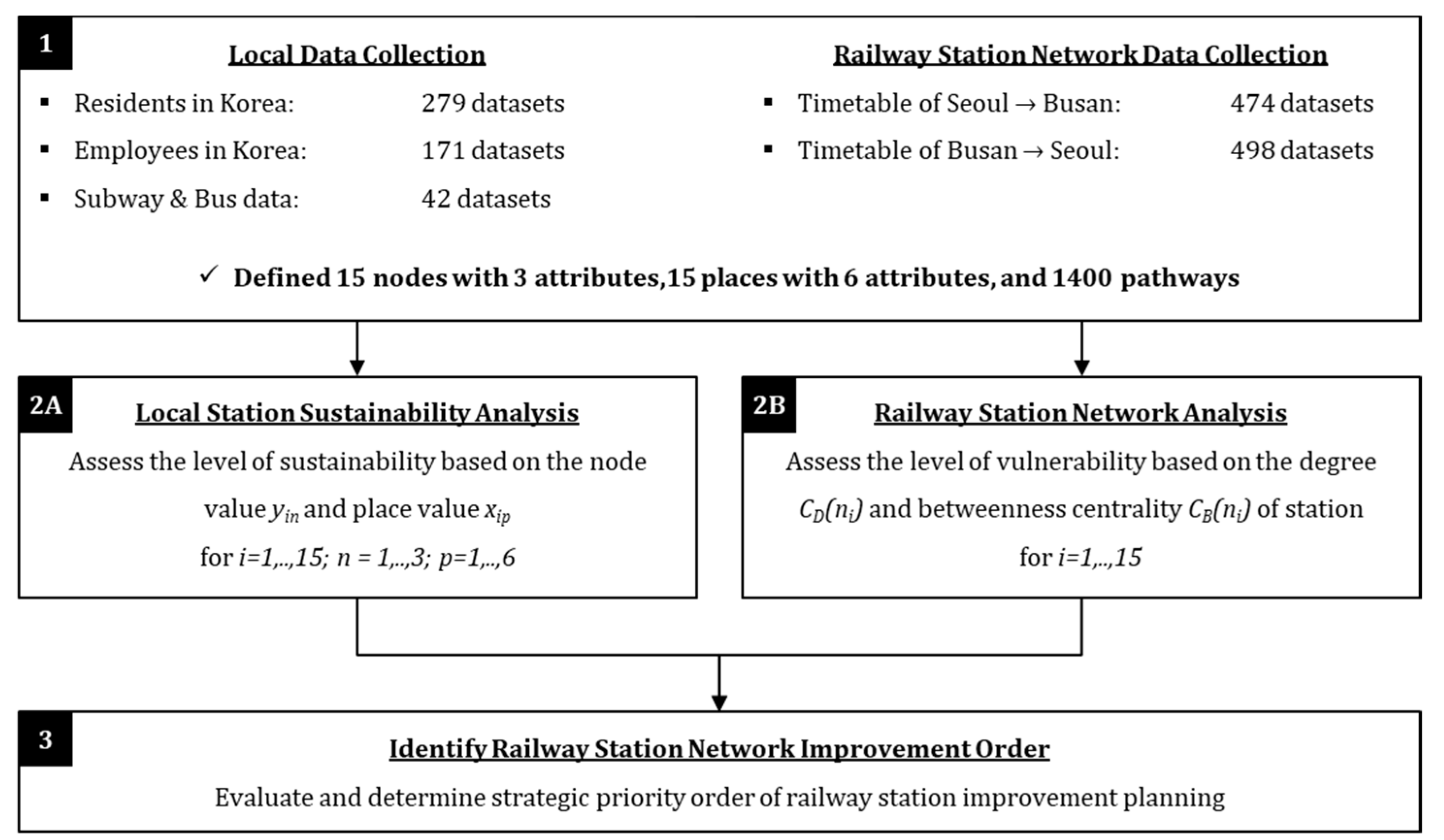
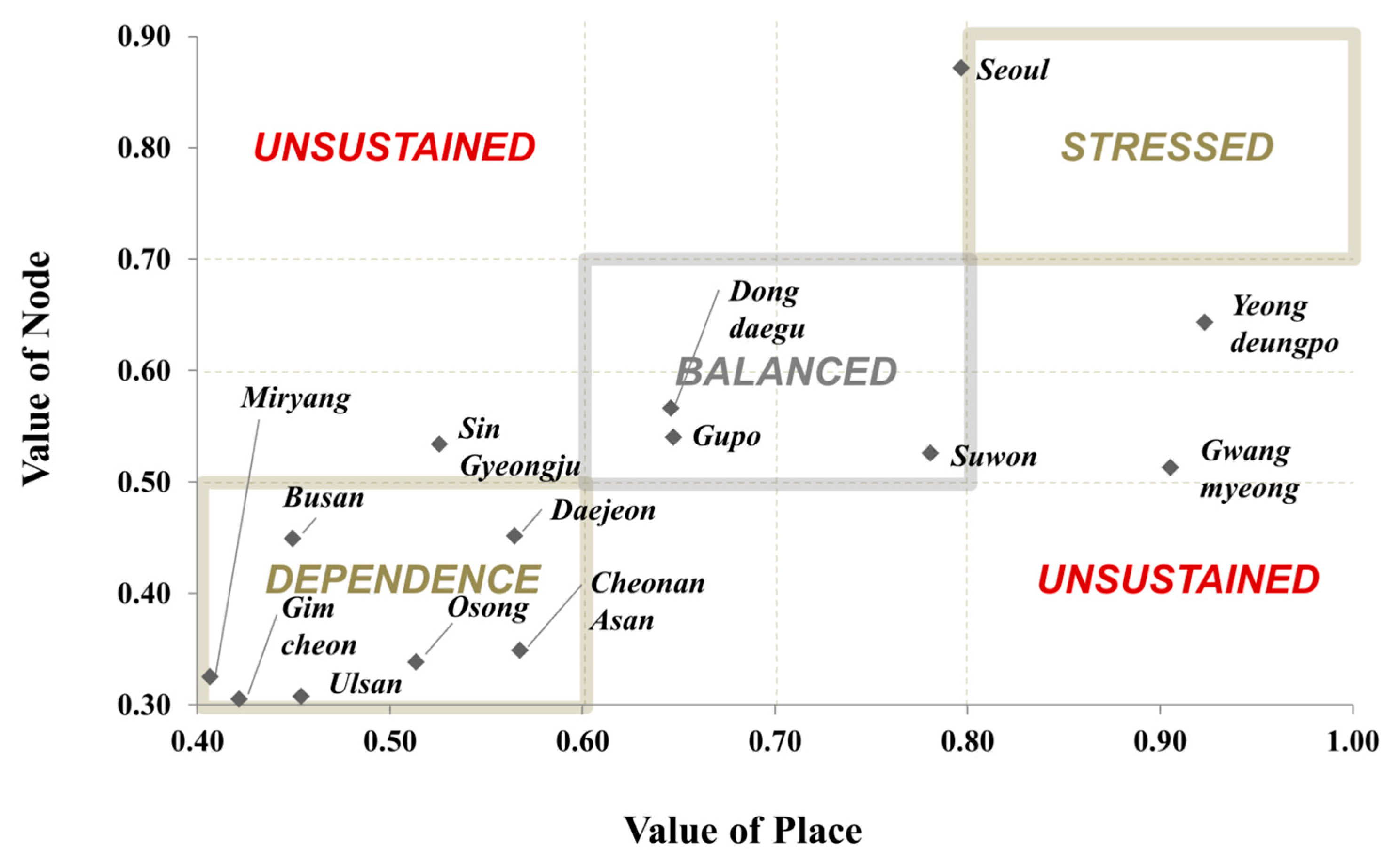

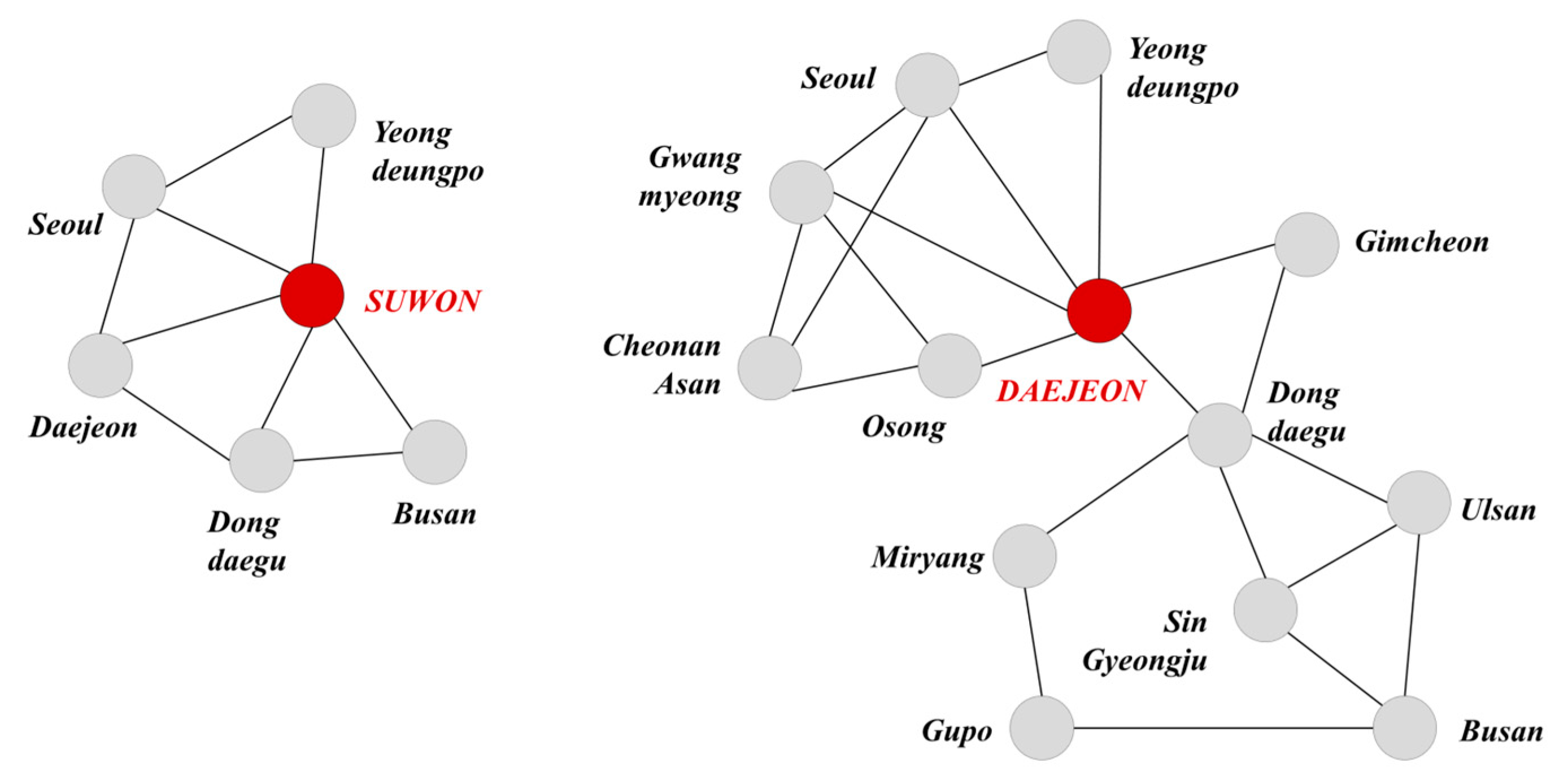
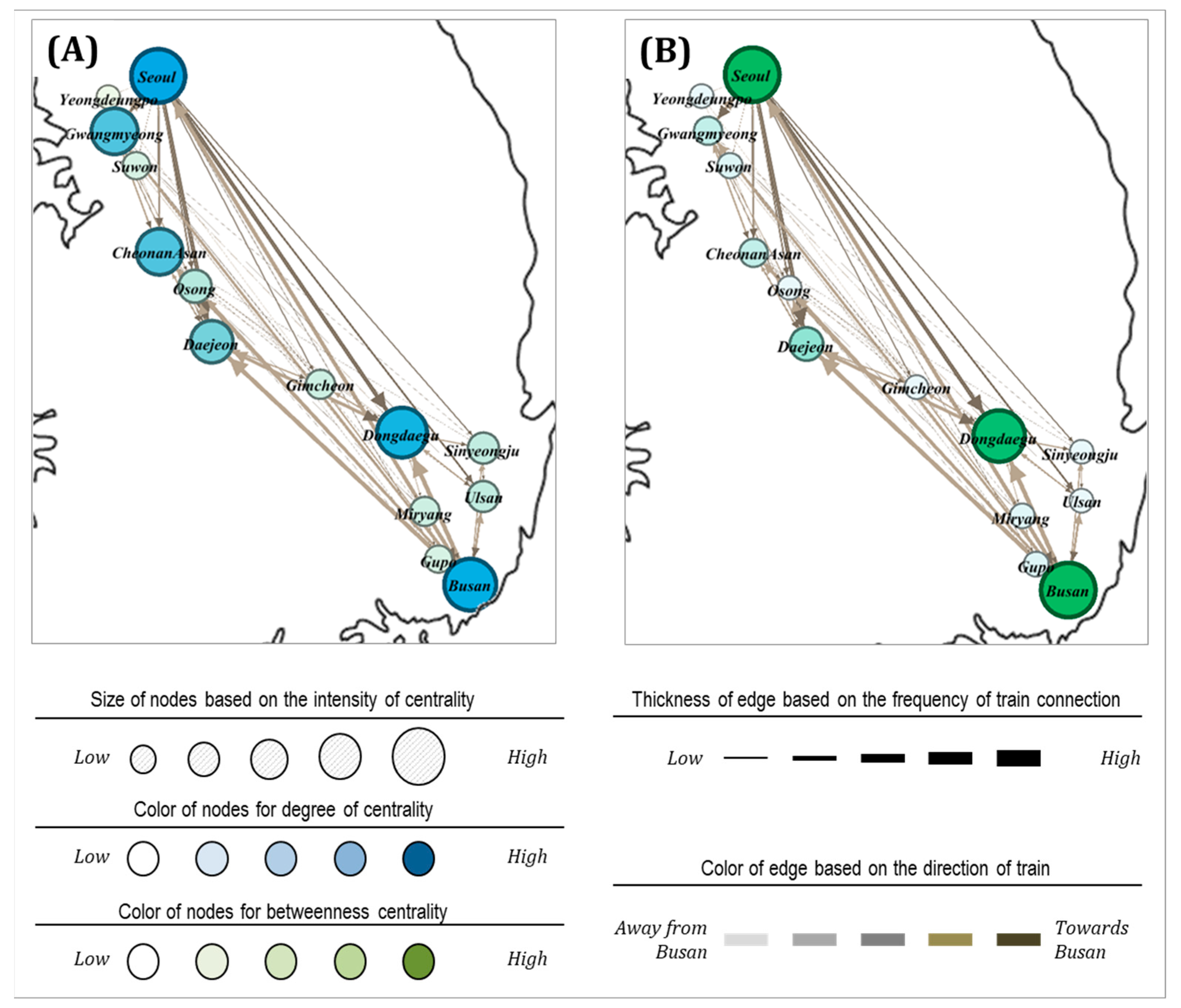
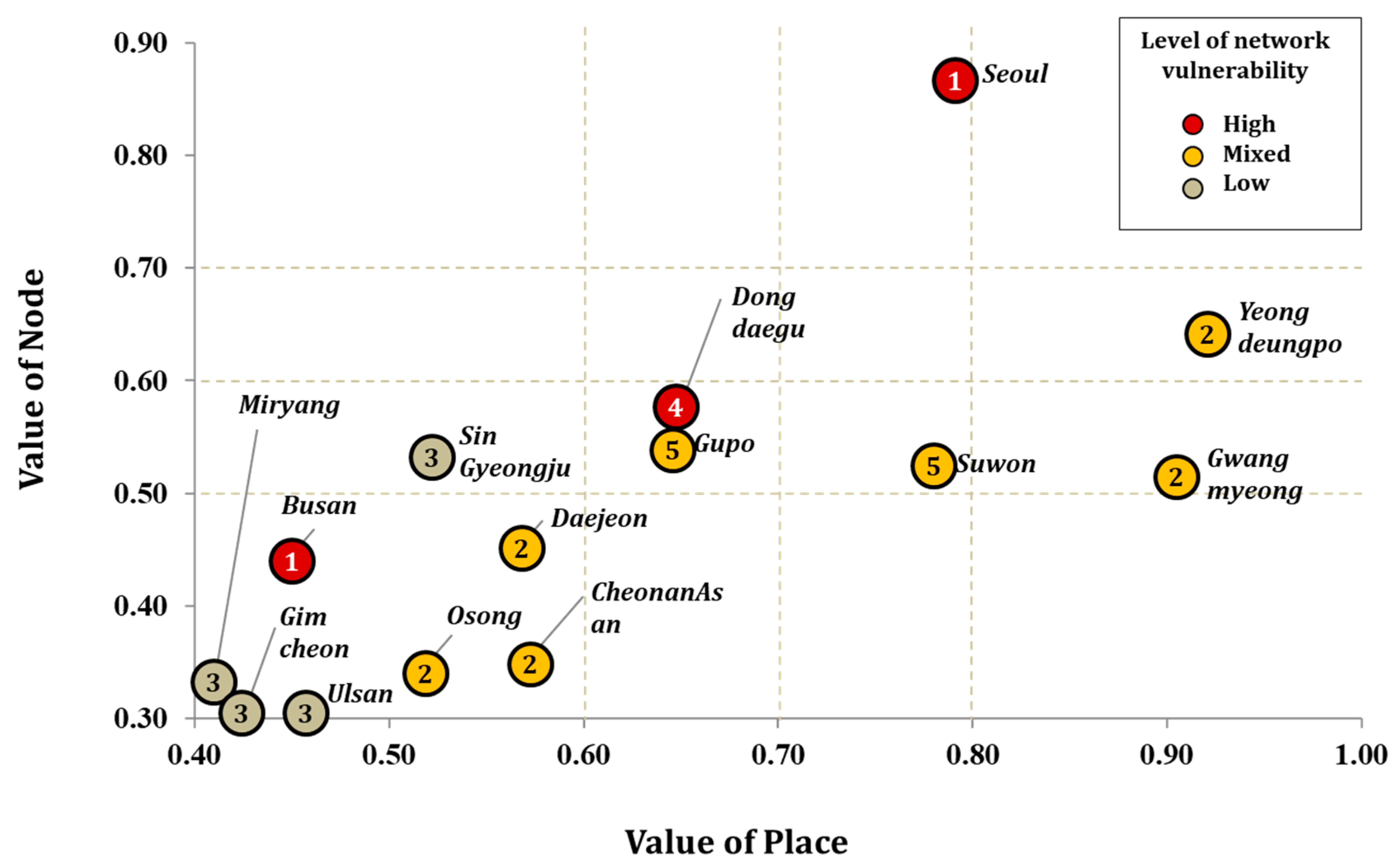
| Description | Measurements of Indicators | |
|---|---|---|
| Frequency of train services | N1 | Average number of arriving and departing trains at the station |
| Number of train connections served | N2 | Average number of train connections that are made at the station |
| Number of nearby subway stations | N3 | Number of subway stations that are within 300 m of the train station |
| Number of nearby bus stations | N4 | Number of bus stations that are within 300 m of the train station |
| Number of available bus services | N5 | Number of busses that stop at train station main bus stop |
| Number of available parking spaces | N6 | Number of official parking spaces available at the train station |
| Number of residents | P1 | Number of residents in the province |
| Number of employees | P2 | Number of employees in the eight economic sectors |
| Degree of multifunctionality | P3 | Standard deviation of number of employees for each economic sector for n sectors at station j where n = 1, …, 8 and j = 1, …, 15 |
| Node | P1 | P2 | P3 | N1 | N2 | N3 | N4 | N5 | N6 |
|---|---|---|---|---|---|---|---|---|---|
| Station 1 (Seoul) | 228,865 | 5,379,000 | 1.00 | 99 | 7 | 4 | 14 | 182 | 1337 |
| Station 2 (Yeongdeungpo) | 369,024 | 5,379,000 | 1.00 | 4 | 6 | 2 | 10 | 126 | 1187 |
| Station 3 (Suwon) | 197,291 | 6,991,000 | 0.81 | 8 | 6 | 2 | 19 | 145 | 1353 |
| Station 4 (Gwangmyeong) | 335,112 | 6,991,000 | 0.81 | 72 | 6 | 1 | 8 | 66 | 1769 |
| Station 5 (CheonanAsan) | 306,452 | 1,336,000 | 0.68 | 58 | 7 | 1 | 7 | 75 | 524 |
| Station 6 (Osong) | 254,022 | 884,000 | 0.73 | 53 | 7 | - | 4 | 25 | 1821 |
| Station 7 (Daejeon) | 233,240 | 799,000 | 0.95 | 112 | 6 | 1 | 13 | 50 | 217 |
| Station 8 (Gimcheon) | 143,095 | 1,491,000 | 0.66 | 34 | 7 | - | 5 | 74 | 448 |
| Station 9 (Dongdaegu) | 351,218 | 1,284,000 | 0.80 | 109 | 6 | 1 | 8 | 122 | 322 |
| Station 10 (Singyeongju) | 258,280 | 1,491,000 | 0.66 | 33 | 7 | - | 3 | 32 | 598 |
| Station 11 (Ulsan) | 218,853 | 606,000 | 0.68 | 1 | 7 | - | 5 | 40 | 1065 |
| Station 12 (Miryang) | 108,219 | 1,775,000 | 0.67 | 14 | 8 | - | 5 | 73 | 105 |
| Station 13 (Gupo) | 308,067 | 1,758,000 | 0.86 | 14 | 8 | 1 | 7 | 46 | 64 |
| Station 14 (Busan) | 89,079 | 1,758,000 | 0.86 | 107 | 6 | 1 | 11 | 69 | 529 |
| P1 Number of Residents | P2 Number of Employees | P3 Degree of Multifunctionality | |
|---|---|---|---|
| N1 Frequency of train services | 0.001 (0.998) | −0.109 (0.711) | 0.313 (0.277) |
| N2 Number of train connections served | −0.226 (0.436) | −0.398 (0.159) | −0.345 (0.227) |
| N3 Number of nearby subway station | 0.214 (0.462) | 0.656 * (0.011) | 0.790 ** (0.001) |
| N4 Number of nearby bus stations | −0.062 (0.832) | 0.617 * (0.019) | 0.624 * (0.017) |
| N5 Number of available bus services | 0.100 (0.734) | 0.648 * (0.012) | 0.555 * (0.039) |
| N6 Number of available parking spaces | 0.249 (0.392) | 0.603 * (0.022) | 0.153 (0.602) |
| Station | Value of Place (xip) | Value of Node (yin) |
|---|---|---|
| Station 1 (Seoul) | 0.80 | 0.87 |
| Station 2 (Yeongdeungpo) | 0.92 | 0.64 |
| Station 3 (Suwon) | 0.78 | 0.53 |
| Station 4 (Gwangmyeong) | 0.91 | 0.51 |
| Station 5 (CheonanAsan) | 0.57 | 0.35 |
| Station 6 (Osong) | 0.51 | 0.34 |
| Station 7 (Daejeon) | 0.56 | 0.45 |
| Station 8 (Gimcheon) | 0.42 | 0.31 |
| Station 9 (Dongdaegu) | 0.65 | 0.57 |
| Station 10 (Singyeongju) | 0.53 | 0.53 |
| Station 11 (Ulsan) | 0.45 | 0.31 |
| Station 12 (Miryang) | 0.41 | 0.33 |
| Station 13 (Gupo) | 0.65 | 0.54 |
| Station 14 (Busan) | 0.45 | 0.45 |
| Low Degree | High Degree | |
|---|---|---|
| Low betweenness centrality | Station 8 (Gimcheon) Station 10 (Singyeongju) Station 11 (Ulsan) Station 12 (Miryang) ✓ Least exposed to vulnerability | Station 4 (Gwangmyeong) Station 5 (CheonanAsan) Station 7 (Daejeon) ✓ Connections are redundant, passengers may bypass |
| High betweenness centrality | No stations ✓ Critical stations that enable network flow. Highly exposed to vulnerability | Station 1 (Seoul) Station 9 (Dongdaegu) Station 14 (Busan) ✓ Most important stations to vulnerability |
| Station | Local Performance Assessment | Rank | Network Vulnerability Exposure | Recommended Improvement Order for Sustainable Railway Station Network Management |
|---|---|---|---|---|
| Station 8 (Gimcheon) | Dependency | 1 | Low | 3 |
| Station 11 (Ulsan) | Dependency | 1 | Low | 3 |
| Station 12 (Miryang) | Dependency | 1 | Low | 3 |
| Station 1 (Seoul) | Stressed | 1 | High | 1 |
| Station 4 (Gwangmyeong) | Stressed | 1 | Mixed | 2 |
| Station 2 (Yeongdeungpo) | Unbalanced | 2 | Mixed | 2 |
| Station 3 (Suwon) | Unbalanced | 2 | Mixed | 5 |
| Station 6 (Osong) | Unbalanced | 2 | Mixed | 2 |
| Station 7 (Daejeon) | Unbalanced | 2 | Mixed | 2 |
| Station 9 (Dongdaegu) | Unbalanced | 2 | High | 4 |
| Station 13 (Gupo) | Unbalanced | 2 | Mixed | 5 |
| Station 14 (Busan) | Unbalanced | 2 | High | 1 |
| Station 5 (CheonanAsan) | Balanced | - | Mixed | 2 |
| Station 10 (Singyeongju) | Balanced | - | Low | 3 |
Publisher’s Note: MDPI stays neutral with regard to jurisdictional claims in published maps and institutional affiliations. |
© 2021 by the authors. Licensee MDPI, Basel, Switzerland. This article is an open access article distributed under the terms and conditions of the Creative Commons Attribution (CC BY) license (https://creativecommons.org/licenses/by/4.0/).
Share and Cite
Kim, J.-S.; Shin, N. Planning for Railway Station Network Sustainability Based on Node–Place Analysis of Local Stations. Sustainability 2021, 13, 4778. https://doi.org/10.3390/su13094778
Kim J-S, Shin N. Planning for Railway Station Network Sustainability Based on Node–Place Analysis of Local Stations. Sustainability. 2021; 13(9):4778. https://doi.org/10.3390/su13094778
Chicago/Turabian StyleKim, Joon-Seok, and Nina Shin. 2021. "Planning for Railway Station Network Sustainability Based on Node–Place Analysis of Local Stations" Sustainability 13, no. 9: 4778. https://doi.org/10.3390/su13094778
APA StyleKim, J.-S., & Shin, N. (2021). Planning for Railway Station Network Sustainability Based on Node–Place Analysis of Local Stations. Sustainability, 13(9), 4778. https://doi.org/10.3390/su13094778







